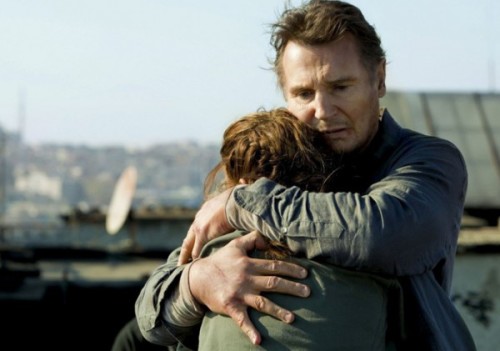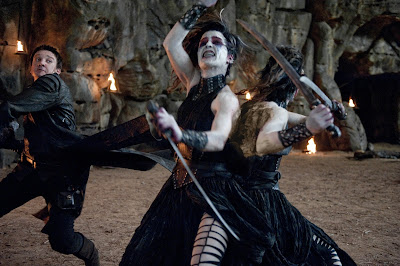
Written by Elizabeth Kiy.
There are certain movies I watch whenever I visit my father. I would never chose to watch them on my own, but I enjoy them enough with him. These movies are instantly gratifying, explosions of car crashes and car chases, kidnappings and jewel thefts and mistaken identities and usually, the strong, comforting presence of his favorite movie star, Liam Neeson, the new model of masculinity.
With his soft Irish accent, his politeness and grooming, he’s a completely different animal from our old action heroes. He’s muscular but still human looking- not a steroid monster like 80s heroes like Stallone and Schwarzenegger. He can love, he can cry, but he can still seek revenge or save your life; however, like these old models, his heft still imposes. Though he kicks down doors and ends lives with violence, he’s smart, well-trained and tactical, outsmarting the villains as often as he actually comes to blows with them.

In Taken, the film that established Neeson as “The New Man,” he’s Bryan Mills, an ex-CIA operative on a mission to save his daughter, Kim (Maggie Grace) from sex traffickers who have kidnapped her while on vacation in France. Besides Neeson’s emergence as a one-man killing machine, it’s not a wholly original film; it’s essentially a rape revenge plot where a daughter and her virginity are entrusted to the protection of her father.
However, when looked at as a trilogy, the Taken films are all about Bryan’s relationship with his daughter as she becomes a woman and he is no longer sure how to relate to her. It’s a common real life situation writ large, and a wholly unexpected through-line for an action franchise.

He tries to figure out how to balance being sensitive and being manly. He doesn’t know how to talk to his daughter anymore; in the first film, they have a strained relationship. He attempts to get through to her by getting her a meeting with her favourite singer who he is acting as a bodyguard for, but the real way he is able to show his love is by saving her life.
When they return home, she’s ready to love him and talk to him again, becoming so close as a family that she and her mother (Famke Janssen), his ex-wife, visit him in Istanbul in the sequel.
In the third movie, their relationship is showing growing pains again. Kim’s in college and Bryan buys her a giant teddy bear for his birthday, adorably excited about the gift. You can feel his heart break when she rejects the bear because she’s too old for it. He wants her to be his little girl, looking at him with stars in her eyes again; we find out she’s pregnant and there may soon be another little girl to look up to him.
In Taken, Bryan is on a time crunch to save Kim’s virginity as well as her life. While her sexually active friend is almost immediately left to die in a makeshift junkyard brothel with no one to care about her, as a virgin, Kim is saved to be auctioned off to a cabal of wealthy international men, which gives Bryan more time to save her. When Bryan finally tracks her down and takes her home, she seems undamaged by her ordeal. By Taken 3, when Kim discovers she is pregnant, it appears that her virginity was saved for the ultimate purpose of becoming a mother.

As a trilogy, the Taken films chronicle Kim’s apprenticeship with her father. After being a damsel in distress rescued in the first film, she returns in Taken 2 to fight against men related to her original kidnappers, getting her revenge on them as the attempt to get revenge on Bryan. When Bryan and her mother, Lenore, are kidnapped, Kim follows Bryan’s instructions over the phone, locating him in the city and providing him with weapons at risk of her life, instead of hiding out at the American Embassy like he originally instructs her to. In Taken 3, a riff on The Fugitive, Kim helps hide her father and investigates her mother’s murder. The culmination of her training is an interrogation scene where a cop questions her about Bryan’s whereabouts and his relationship with Lenore; as she answers him, she sounds exactly like her father.

Famke Janssen, as Bryan’s ex-wife and Kim’s mother, fares less well across in the franchise. Bryan’s first indication in Taken–that something may go wrong on Kim’s trip to France–is his last minute discovery that Kim and her friend are planning to follow the band U2 on their European tour. It seems to have little to nothing to do with the actual human trafficking plot, but is used to paint Lenore as a bad mother who isn’t careful enough about her daughter’s safety. In the sequel, she waits around to be saved by the combined efforts of her husband and daughter and by Taken 3, she’s barely around, succumbing to Women in Refrigerators syndrome in the first few minutes of the film.

It seems that Kim’s pregnancy is intended to present her a both masculine and feminine, taking in a bit of both her mother (whose only real role was to have a daughter to be saved in the first place) and her father. Taken 3 flirted with Kim’s decision whether or not to have an abortion, though in the end, there wasn’t really a point. Of course, this big budget mainstream action film isn’t going to end with a character deciding to get an abortion, but it’s interesting that it was even presented as an option and that this new model for masculinity supported her right to chose either way.
One can only wonder if Liam Neeson will fight through Taken 4 with his new grandchild strapped to his chest in a Baby Bjorn.
Elizabeth Kiy is a Canadian writer and journalist living in Toronto, Ontario.




